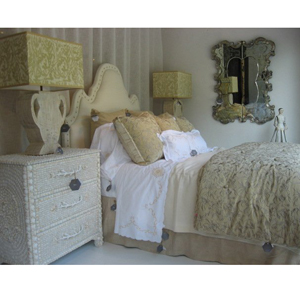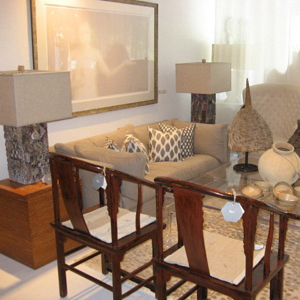 |

Mixing vintage linens with new ones is one way Atlanta-based retailer "BEE" displays its intriguing vignettes of eco-friendly home furnishings.

Responsible, sustainable design doesn't have to be boring. Instead, it's the theme that ties together a blending of styles, design periods, and mixed materials. Photo courtesy of Jillian Pritchard Cooke, BEE.
Responsible, sustainable design doesn't have to be boring. Instead, it's the theme that ties together a blending of styles, design periods, and mixed materials. Photo courtesy of Jillian Pritchard Cooke, BEE.
Organic Thinking
When it comes to selling environmentally conscious furniture, some stores—like Atlanta-based home furnishings retailer "BEE"—just do it right. It carries three levels of products, each with its own enviornmental story, making it easy to understand a product's environmental footprint:
PURE: Items that are completely chemical free, have no dyes added to them, and are in their purest state.
RESPONSIBLE: Pieces that have been made in a conscientious way. Examples include objects painted in no-VOC paints, bleached with non-chlorine bleach, dyed with low-impact vegetable dyes, and objects that have been saved from landfills by being repurposed.
SUSTAINABLE: Objects that have stood the test of time and were constructed using the most sustainable resources including FSC-certified woods, reclaimed zinc, recycled concrete and antiques.
-
Top Building Trends: Health & Environment
The National Association of Home Builders offers its Top 10 trends.
- by Trisha McBride Ferguson
Environmentally friendly construction and homes designed for improving the homeowners' health are the hot trends to watch for this year, according to the National Association of Home Builders (NAHB). In its list of top trends (prepared by its design committee and delivered at the International Builders’ Show), NAHB placed the highest priority on the growing concern for health and the environment, and secondly, the paradigm shift in the economy and its impact on lifestyles across generations.
Healthy Design
The focus on holistic building includes more than just the sustainability of building materials and their impact on the environment—it also focuses on the creation of healthy environments inside the home.
“In order to have a truly holistic building process, the building industry internationally must put a high priority on health by continuing to move toward the exclusive use of non-toxic products without sacrificing a beautiful and thoughtfully designed home,” says Jillian Pritchard Cooke, an international eco interior designer based in Atlanta and founder of Wellness Within Your Walls™. “Healthy interior air quality will only result when a toxin-free environment becomes available to everyone.”
The 10 trends are:
1. A Holistic Approach: The entire building industry will begin to place a high priority on integrating natural resource and health and community concerns into building design. This new holistic approach examines the impact of all the elements inside a building, ranging from water conservation and indoor air quality to minimizing waste and toxin emissions. Planned communities are a solution (growing in popularity) that encourages this type of healthy and convenient lifestyle.
2. Multi-Family Homes: Multi-family housing, including adaptive reuse, rezoned single-family neighborhoods, live-work projects and infill opportunities, are a few of the alternatives on the horizon.
3. Downsizing: As consumers downsize their homes, the building industry is responding with smaller, more-efficient square footage options that reduce building waste while utilizing technology.
4. Multigenerational Living: With two and three generations living together, the need for retire-in-place home solutions is growing. New home designs will accommodate the elderly with areas for privacy on the first floor, while providing living quarters for their children on the upper floor, and rooms for their grandchildren on sublevels. Homes featuring a large kitchen for shared meals on the main level with private morning kitchens on other levels will also be seen.
5. Remodeling: The volume of remodeling now exceeds that of new single-family construction. As homeowners find creative ways to finance these projects, they are modifying their homes for elder care, and to accommodate the evolving needs of their growing families.
6. Resurgence of Mid-Century Design: Organic architecture that expresses clean simplicity through the integration of nature will continue to be an important trend. This includes floor plans with an abundance of natural light and designs that reduce energy consumption.
7. Reinventing Streetscapes: Expect to see homes with front elevations that are unique and memorable because of the interaction of styles, textures, colors and materials used.
8. Americanization/Globalization: Global thinking will become evident in all aspects of home building through the cross-pollination of cultures among artists, designers, architects, builders and developers.
9. Fundamental Financing: Builders will strive to add value and create buyer confidence through financial transparency.
10. Timeshares and Travel Clubs: As an alternative to buying a second home, people will choose to buy timeshares and travel clubs—which are less risky, less costly, and offer choices in worldwide locations.

